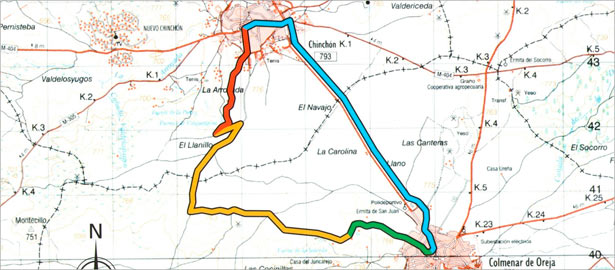Web de turismo de Chinchón
Routes
Train route
 Download route's map
Download route's map
The name of this route is due to the oncoming train to Chinchon and Colmenar de Oreja, who was one of the branches of the line of Arganda. It was known popularly as the Grapevine-breaker train as it was so slow that people gave up time to get off and go picking grapes from vines adjacent to the tracks. There were times it took 6 hours to do a 60 Km. Hence the popular saying "The Arganda train beeps more than walk."
The first section of the railway was opened in 1886 and reached Arganda. Five years later came to Morata, and in 1902 opened the stretch to Chinchon and a year later came to Colmenar de Oreja, making this location quarries the stone could carry more comfortably.
Today there are still remnants of the old railway embankments such as running on the train route, or the bars near the Institute of Chinchon, who still retain the name of "Bar de la Estación".
We began a path half distance the population of Chinchon and go through the nearby town of Colmenar de Oreja doing a circular route since the start and end point will be the same.
On the way you will see one of the most beautiful main squares of Spain. Walker will also enjoy other monuments like churches, chapels, etc..
Although urban and monumental features are important in this route, also the landscape that can be enjoyed should be considered very attractive.
The route will take us along the path of an old railway line, between hills, mountains and cultivated fields to complete a route recommended in all seasons except summer heat.
Grapevine-breaker train path
It starts from the Plaza Mayor Chinchon, to climb the big street and continue down the Benito Hortelano street between typical houses to the junction of the road, crossed it and came to the institute. At its height, we turn right down from Álvarez Laviada street. The road extends in a path that leaves Chinchón towards Colmenar de Oreja.
We go now the old railway line which opened early in the century. The road is almost flat since the railroad demanded it, so in some sections were constructed slopes to match the incline. It is wooded with acacia and young elms until its entry into Colmenar against Sports Centre. We sorround this road and go outside Murillo street,where we continue to the end and then we turn right through Las Canteras street till the square of the bus stop.
Poza del Moral path
We continue straight on Afuera Tinajeros street and turn right through Poza del Moral street to leave the village. This street becomes a way to leave the stone factories and after a steep decline got to the Poza del Moral fountain beside a wall.
Cultivated fields path
We leave the fountain and up the alley parallel to the wall. The road is in very bad shape, but in the high we can relax and contemplate on our left the hills and valleys dotted with olive groves.
We continue along the path until you reach a track where you turn left between cereal crops, vineyards, etc.. Later we found a fork, and choose the right path until we reach a crossroad of three roads exiting. We continue down the center walking up a small hill that will take us a few feet away to a valley where the road we bring ends.
From this point we turn left and head back to Chinchón, from which we can see, in front of us, the church spiers and houses uptown. At the junction with a large cairn separating two roads, we continue straight up to the pine and once there turn left along a path diagonally down to the area of fountains, benches and tables. In the background there is an old rehabilitated laundry and some barbecues.
We are already in Valquejigoso, recently conditioned space for the enjoyment of visitors and residents of Chinchon.
Castillo de Chinchón path
We leave Valquejigoso through the path that climbs Chinchón, leaving the laundry to the left side. This path between elms, acacia and olive hill will take us, bordering the hill, to Castillo de Chinchón that stands on a knoll overlooking the entire length of the valley, a construction of XVI century badly damaged by the many times he has been targeted by the various wars that ravaged the area.
Leaving the castle we go out to the main road and enter the town by the Avenida del Regimiento avenue that takes us to the Plaza Mayor, through the Casa de la Cadena opposite the Parador, the former Convent of San Agustín.





